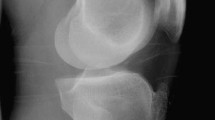Abstract
Tunnel cyst formation is a rare complication after anterior cruciate ligament reconstruction, usually occurring 1–5 years post-operatively, which may occasionally be symptomatic. There are multiple proposed theories regarding the etiology of tunnel cysts. Theories include necrosis, foreign-body reaction, lack of complete graft osteo-integration, and intravasation of articular fluid. It is important to know if the tunnel cysts are communicating or not communicating with the joint, as surgical management may be different. Imaging characteristics on magnetic resonance images (MRI) include tibial tunnel widening, multilocular or unilocular cyst formation in the graft or tibial tunnel, with possible extension into the pretibial space, intercondylar notch, and/or popliteal fossa. The MR imaging differential diagnosis of tibial tunnel cysts includes infection, foreign-body granuloma, or tibial screw extrusion. Importantly, to the best of our knowledge, graft failure or instability has not been reported in association with tibial tunnel cysts.







Similar content being viewed by others
References
Bencardino JT, Beltran J, Feldman MI, et al. MR imaging of complications following anterior cruciate ligament graft reconstruction. Radiographics. 2009;29(7):2115–26.
Meyers AB, Haims AH, Menn K, et al. Imaging of anterior cruciate ligament repair and its complications. Am J Roentgenol. 2010;194:476–84.
Bedi A, Maak T, Musahi V, et al. Effect of tibial tunnel position on stability of the knee after anterior cruciate ligament reconstruction. Is the tibial tunnel most important? Am J Sports Med. 2011;39(2):366–73.
Matsumoto A, Howell SM. Avoiding posterior cruciate ligament and roof impingement with transtibial anterior cruciate ligament reconstruction: keys to correct tunnel placement. Tech Orthop. 2005;20(3):211–7.
Flik K, Bach B. Anterior cruciate ligament reconstruction using an endoscopic technique with patellar tendon autograft. Tech Orthop. 2005;20(4):361–71.
Magnussen RA, Lawrence JT, West RL. Graft size and patient age are predictors of early revision after ACL reconstruction with hamstring tendon autograft. Arthroscopy. 2012;28(4):526–31.
Iorio R, Vadala A, Argento G, et al. Bone tunnel enlargement after ACL reconstruction using autologous hamstring tendons: a CT study. Int Orthop. 2007;31:49–55.
Simonian PT, Wickiewicz TL, O’Brien SJ, et al. Pretibial cyst formation after anterior cruciate ligament surgery with soft tissue autografts. Arthroscopy. 1998;14:215–20.
Deie M, Sumen Y, Ochi M, et al. Pretibial cyst formation after anterior cruciate ligament reconstruction using auto hamstring grafts: two case reports in a prospective study of 89 cases. Magn Reson Imag. 2000;18:973–7.
Tsuda E, Ishibashi Y, Tazawa K, et al. Pretibial cyst formation after anterior cruciate ligament reconstruction with a hamstring tendon autograft. Arthroscopy. 2006;22(6):691.e1–e6.
Lamprakis AA, Fortis AP, Dimas A. Rejection reaction to stabilizing bolts after ACL reconstruction: a case report. Knee Surg, Sports Traumatol, Arthrosc. 2008;16:19–23.
Martinek V, Friederich NF. Tibial and pretibial cyst formation after anterior cruciate ligament reconstruction with bioabsorbable interference screw fixation. Arthroscopy. 1999;15:317–20.
Victoroff BN, Paulos L, Beck C, et al. Subcutaneous pretibial cyst formation associated with anterior cruciate ligament allografts: A report of four cases and literature review. Arthroscopy. 1995;11:486–94.
Gonzalez-Lomas G, Cassilly RT, Remotti F, et al. Is the etiology of pretibial cyst formation after absorbable interference screw use related to a foreign body reaction? Clin Orthop Relat Res. 2011;469:1082–8.
Sekiya JK, Elkousy HA, Fu FH. Recurrent pretibial ganglion cyst formation over 5 years after anterior cruciate ligament reconstruction. Arthroscopy. 2004;20:317–21.
Ahn JH, Lee YS, Chang MJ. Post-tibial cyst formation over 2 years after posterior cruciate ligament reconstruction. Knee Surg, Sports Traumatol, Arthrosc. 2008;16:996–8.
Sanders TG, Tall MA, Mulloy JP, et al. Fluid collections in the osseous tunnel during the first year after anterior cruciate ligament repair using an autologous hamstring graft: natural history and clinical correlation. J Comput Assist Tomogr. 2002;26(4):617–21.
Conflict of interest
The authors declare they have no conflicts of interest.
Author information
Authors and Affiliations
Corresponding author
Rights and permissions
About this article
Cite this article
Ghazikhanian, V., Beltran, J., Nikac, V. et al. Tibial tunnel and pretibial cysts following ACL graft reconstruction: MR imaging diagnosis. Skeletal Radiol 41, 1375–1379 (2012). https://doi.org/10.1007/s00256-012-1486-2
Received:
Revised:
Accepted:
Published:
Issue Date:
DOI: https://doi.org/10.1007/s00256-012-1486-2




